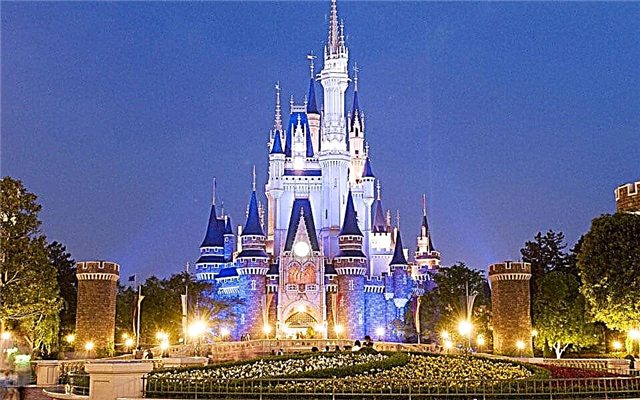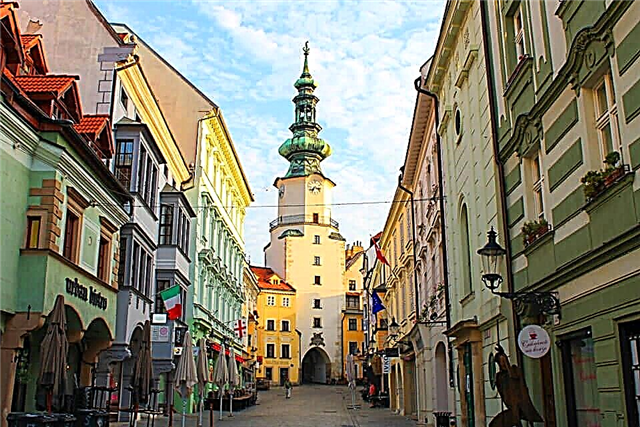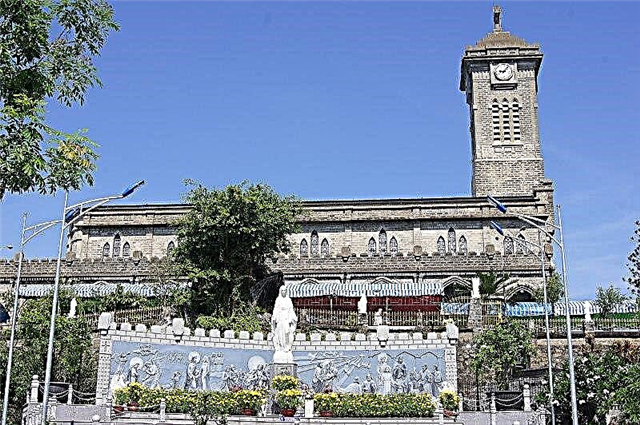Address: Russia, Nizhny Novgorod region, Nizhny Novgorod, Melnichiy per., 8
Based in 1221
Main attractions: Cathedral of the Annunciation of the Blessed Virgin Mary (built in 1648-1649), the Church of the Dormition of the Blessed Virgin Mary (1652), the Church of Alexy, Metropolitan of Moscow (early XIX century), Church of St. Sergius of Radonezh (1690), hospital building (XVII century)
Shrines: a miraculous copy of the Korsun Icon of the Mother of God, an icon of St. Metropolitan Alexy with a particle of relics (15th early 16th centuries), a miraculous icon of the Smolensk Mother of God
Coordinates: 56 ° 19′24.05 ″ N 43 ° 58′38.06 ″ E
Content:
The oldest monastery in Nizhny Novgorod stands on a wide, elevated terrace of the steep right bank of the Oka. It can be clearly seen from the river, and from the slope, and near the monastery, there is always a feeling of spaciousness and freedom. The long history of the Annunciation Monastery is full of dramatic events. Its buildings were subjected to merciless enemy invasions, burned in fires and rebuilt many times. But today the ancient monastery is being revived.

General view of the monastery from the Kanavinsky bridge
History of the Annunciation Monastery
The history of the ancient Nizhny Novgorod monastery goes back to the times when the Russian state was still being formed. This monastery was founded by the third son of the Grand Duke Vsevolod the Big Nest, and it happened in 1221, when Yuri Vsevolodovich, realizing the important strategic place of the lands surrounding the confluence of the Oka and the Volga, began to build here "Nov Grad" - Nizhny Novgorod. Simultaneously with the city, the Vladimir-Suzdal prince founded a new monastery, designed to protect the city buildings from the side of the river. It is known that the bishop of Vladimir, Saint Simon, took a great part in the creation of the Christian monastery.

View of the monastery from the side of Zalomova street
The arrangement of the new outpost of Russia was accompanied by a struggle with the Mordovians. Diplomatic wars and open battles were common in those days. In the 13th century, the influential prince (inyazor) Purgas headed all the Erzians, and in the Russian chronicles his vast domains were called "Purgas volost". The Mordovian prince defended his rights to the Volga territories and did not want the peoples subordinate to them to convert to the Christian faith.
In January 1229, Prince Yuri Vsevolodovich organized a campaign against the Mordovians and caused considerable ruin to the Erzyans. But a few months later, Purgas gathered an army and struck back at Nizhny Novgorod. His people burned down the villages surrounding the city, the township and the new monastery.

View of the monastery from the side of Melnichny lane
The destroyed monastery had to be rebuilt and rebuilt. However, a hundred years later, a new misfortune came. In 1369, in Nizhny Novgorod, there was such a snowy winter that many of the wooden buildings of the monastery were destroyed, and under the buildings that collapsed from the weight of the snow, several monks died.
The monastery owes its second birth to the care of the Metropolitan of Kiev and All Russia Alexy. Passing through Nizhny Novgorod, Saint Alexy was depressed by the sight of the monastery ravaged by raids and fires. By his order, the monastery received the status of a metropolitan, that is, it began to enjoy the highest position of the church hierarchs. Such care and rich gifts soon transformed the Annunciation Monastery and made it one of the largest feudal farms in the spacious Nizhny Novgorod lands.

View of the Church of Alexy, Metropolitan of Moscow
The monastery flourished and enjoyed the patronage of not only the church authorities. Among the donors for the monastic needs were many merchants, landowners and commoners. The name of one of the trustees remained in history. Osip Ivanovich Ermolov, like his father, constantly visited the monastery, bringing food and money to the monks. Shortly before his death, Osip Ermolov took monastic vows, taking the name Jacob, and assigned most of his estate, located in Teply Stan, to the Annunciation monastery. It is curious that the famous Russian military leader, General Alexei Petrovich Ermolov, is a direct descendant of this benefactor.

Cathedral of the Annunciation of the Blessed Virgin
Many interesting events have survived in the history of the monastery. So, in the 18th century, an ancient handwritten kondakar (collection of chants), created in the 12th or 13th century, was found here. Researchers called it Blagoveshchensky or Nizhny Novgorod and is considered the most ancient monument of Russian hymnography that has survived to this day.
When the Makaryevskaya fair was transferred to Nizhny Novgorod, the Annunciation Monastery, clearly visible from the river, turned out to be just opposite the fairground complex. The monastery became a recognizable trademark of the trading city and attracted many pilgrims.

From left to right: Church of the Assumption of the Blessed Virgin Mary, bell tower, gate church of St. Andrew
After the 1917 revolution, the ancient monastery was closed, and the territory was transferred to the 17th Infantry Division. Since 1948, the Nizhny Novgorod Planetarium has been operating inside the old Alekseevsky Church, which in 2005 was moved to the opposite bank of the Oka, to 20 Revolutionary Street.
The revival of the monastery began in 1993 with the creation of a religious school on its territory. Two years later, his status was raised to theological seminary. Significant restoration and restoration work was carried out on the monastery territory, and now the monastery appears before believers and tourists in all its glory.

Hospital building
Temples and buildings on the monastery territory
The oldest stone building of the monastery that has survived to this day is the majestic Cathedral of the Annunciation. An artel of monastery masons, led by Elder Velyamin Cherstkin, built this temple in 1648-1649. Nizhny Novgorod stonemasons were known as great craftsmen, and some of them were listed as “noteworthy masters of the sovereign”. Danila and Grigory Timofeevs, who were part of Cherstkin's artel, were invited to Moscow in the 1660s to build stone buildings.
The cathedral has a rare end for the 17th century - its central chapter is bulbous in shape, and four others are helmet-shaped. Restoration work in this temple took place in the 80s of the 19th century, and was supervised by the provincial architect Robert Yakovlevich Kilevein. A century later, a second restoration was carried out, during which all five church chapters were covered with copper. This old church has preserved a unique old Russian four-tiered iconostasis and wall paintings.

Church of St. Sergius of Radonezh
The Assumption Church was built in the monastery a little later - in 1652. It was made on a high basement, which housed the kitchen. It is curious that the chimneys here were arranged in such a way that the heat from cooking was redistributed to heat the premises of the temple itself. The refectory and the bell tower adjoin the St. Andrew's Church. Currently, this temple can only be viewed from the outside, as its interiors have not yet been restored. The monks use the premises of the church as warehouses.
Alekseevskaya church was erected in the monastery in the 20-30s of the XIX century. The project of this temple, made in the traditions of classicism, was prepared by architects A.L. Leer and I.I. Mezhetsky. The beautiful, spacious building is surrounded on four sides by neat porticoes with columns.

Theological seminary at the monastery
When the planetarium was located here, the side domes were stripped of the temple, and the height of the main dome was significantly lowered. Today, thanks to the efforts of the restorers, the Alekseevskaya Church has been completely restored, and all five of its gilded domes are visible from afar. In 2007, a porcelain iconostasis, which is quite rare for Russian churches, was placed here. Such iconostases are found only in the churches of Moscow, Valaam and Yekaterinburg.
A small one-domed church of St. Sergius of Radonezh is adjacent to the Annunciation Cathedral. It was built in 1690 and recently restored. The well-groomed monastery territory also houses a hospital building (17th century), buildings of a theological seminary, a necropolis, a worship cross on the site of a destroyed chapel and a monument to the Russian Emperor Alexander III (2013).

Monastic necropolis
In a ravine to the east of the monastery, there is a holy spring - Gremyachiy Klyuch. A legend has survived that Metropolitan Alexy rested near him when he stopped in Nizhny Novgorod on the way to the Golden Horde. A long time ago, a small wooden chapel dedicated to St. Alexis was built next to the holy spring. In 1725, this chapel was rebuilt from stone, but two centuries later, the new authorities decided to demolish the architectural monument "for dilapidation." Today, a picturesque wooden chapel, crowned with a small gilded dome, stands again near the key.

Main gate
Current state and visiting regime
Nowadays, the Annunciation Monastery is an active male monastery, where 9 inhabitants and the abbot live. The monastery territory is open to the public from 7.00 to 19.00. The morning liturgy starts at 8.00, and the evening - at 17.00. Guests of the monastery are expected to comply with the basic rules of the hostel. Smoking, foul language and noisy behavior are not encouraged here. Photographing inside the monastery is paid - 100 rubles.
The patronal feast is celebrated here on April 7th. A list from the Korsun Icon of the Mother of God, which is kept in the Annunciation Cathedral of the monastery, is considered a revered shrine by all believers.

Chapel of Alexy, Metropolitan of Moscow
How to get to the monastery
The monastery is located in the Nizhny Novgorod region, on the right bank of the Oka river, not far from its mouth - near the Kanavinsky bridge (Melnichy per., 8). You can drive up to its territory by buses and minibuses (stops "Blagoveshchenskaya Ploshchad" or "Chernigovskaya Ulitsa") or walk about 1.7 km from the metro station "Gorkovskaya".











